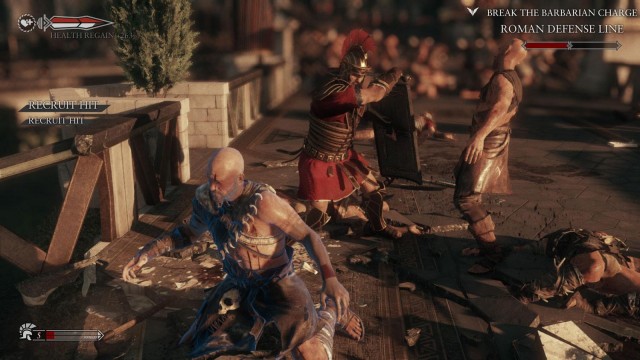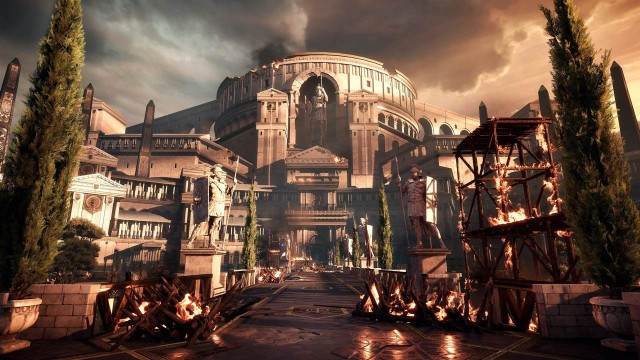The expected orchestral score plays alongside the violence and majesty of Ryse, further hammering home its top-notch production values. Even the passive pause menus come with their own triumphant orchestral themes, and it’s yet another way that Ryse absolutely must assert its triple-A polish to gamers at all times.
Of course, more impressive are the brutal, vivid sound effects, which really bring players into the thick of Roman battle. The sound of blades cleaving flesh and bone, stabbing through enemies and knocking back crowds is done with pitch-perfect realism, as is the power and weight behind tossing or knocking enemies around with your shield, or feeling their own strikes bounce off of Marius’s thick coat of armour.
Even with the gameplay feeling far from fast-paced, every sound effect is realized with incredible authenticity, whether it’s a widespread battle between Roman and Briton forces, or just a stealthy forest skirmish between Marius and some scouts during a quiet one-man mission. Interaction with the environment is equally authentic and true-to-life, giving Ryse an incredible sense of immersion that most action games couldn’t hope to achieve.
Appropriately, the voice acting is also outstanding as well. Players will have to suspend their disbelief in regards to the many Roman characters speaking the Queen’s English, but beyond that, both dialogue and performances are superb. The corrupt villains are especially memorable, equal parts eccentric, decadent and unstable, while Marius himself carries with him all the presence of a true Centurion warrior, with the weight of tragedy and his very empire on his shoulders. As much as the gameplay can occasionally descend into a chore of disengaged button prompts, at least the various personalities of Ryse will keep players invested in what’s going on for the duration of the story.
Like the visuals, you’d be hard-pressed to find any noticeable issues with the audio in Ryse, which is polished to a sheen!
For all of Ryse’s technical bells and whistles, the gameplay is where the experience too often tends to stumble. For a game so powerful and lifelike, Ryse feels like a disappointingly passive play experience, furthering the aftertaste of it feeling like a glorified Xbox One tech demo.
In the main single-player story, you’ll take control of Marius Titus across eight chapters, which present wholly linear set pieces that you move between, only occasionally able to poke around for one of three arbitrary collectibles (Vistas, Chronicles and Scrolls), but mostly just being ushered to the next fight sequence. The lingering design elements of Ryse’s original pitch as an Xbox 360 Kinect game are noticeable, since a lot of the combat also reflects these very simple rhythm-based inputs, which players just apathetically punch in, matching colours to the X, Y, B and A buttons, so they can dispatch their repetitive foes and keep moving.
It’s very frustrating to be presented with such beautiful environments that you can’t actually explore. It’s even more annoying to encounter such detailed enemies that only come in a few boring varieties. Early on, you’ll fight basic grunts that you can easily slash through by just mashing X, occasionally pressing A to deflect a strike. Then you move on to grunts with shields who have to be staggered by occasionally pressing Y to shield bash them amidst pressing X. Then you meet enemies that use heavy attacks you need to roll away from with B, but still mostly attack the same way. To put it bluntly, combat in Ryse quickly becomes brainless, and even when you crank the difficulty, most gamers will still be able to power through almost any scenario with little fear of defeat or danger.
Initially, the ability to press the right trigger to execute an injured enemy is cool, since there’s a decent amount of variations that Marius can employ to have his foes meet a bloody end. The first few times you see him hack off arms and disembowel his quarries, you’ll undeniably be impressed. After the first few times though, it gets old, and the gore ceases to engage the player at all, much like the combat itself. This is made worse by absolutely nothing happening if you miss a prompt or press the wrong button. The execution proceeds as normal, and you’re just given less EXP for it, which really means nothing.
A more interesting idea is how the game uses the four directions on the D-Pad to award Marius different benefits for executing enemies. Down rejuvenates your health, right gives you more EXP, left gives you more Focus (allowing you to press the right bumper to slow down enemies temporarily and land several free hits), and up increases your damage output as you maintain a combo without being hit. Even this however has little impact on gameplay, since the health restoration is very generous, and most of the time, players will just want to accrue EXP so they can make Marius an even bigger bruiser by unlocking various upgrades.
Similar to God of War and its red orbs, accumulating EXP will allow you to unlock new executions for Marius, as well as increase his health and focus, give him greater EXP increments, increase the amount of time Marius can score free hits on enemies in a focus state, allow him to become faster and deadlier if he maintains a certain combo streak, and more. You mainly unlock these upgrades by spending Valor you earn from defeating enemies, with the also-awarded EXP unlocking more upgrade options you can purchase with Valor. Failing that, you can also buy upgrades with Gold, which can be earned from playing the multiplayer, or through spending real-world money across a slew of microtransactions.
Yes, Ryse is yet another first-party Xbox One launch exclusive with microtransactions, and they’re at their most redundant and sleazy here, especially since playing the story normally can get you a nearly fully-upgraded Marius in just a few hours. The fact that Ryse features microtransactions at all after initially demanding $60 to buy is inexcusable, but it’s this particular game that stands as the worst evidence that Microsoft is starting to get really carried away with this practice, and they need to be called out on it!
Forza Motorsport 5 locking heaps of cars and content behind pay walls is greedy, no two ways about it. Crimson Dragon trying to chop out and sell beneficial gameplay components as DLC is greedy, again, no two ways about it. Killer Instinct is at least a free-to-play game, but even the amount of content that it puts behind pay walls is ludicrously excessive.
Ryse however isn’t even clever about its microtransactions. It’s just Microsoft desperately and embarrassingly begging for your money. Yes, they’re optional, especially since they’re easily ignored with how quickly you can upgrade Marius, but that’s not the issue. The issue is that Microsoft is putting microtransactions in a game that doesn’t need them, just for the sake of doing it, and that’s very distressing for prospective Xbox One exclusives to come!
Pack it in, Microsoft! You’re making yourself look bad!
Anyway, off that sour note, Ryse does have some neat ideas at various points in the story. You can direct your troops to various strategic placements to create different advantages during combat, such as whether or not you can summon a hail of arrows, or whether you stop siege fire from bombarding you or not. This is a very neat idea that’s unfortunately half-baked, since it ultimately doesn’t affect the challenge in any real way.
This is also true of the times where you’ll form a phalanx that you can command to shield themselves from arrows, and retaliate with pila at your discretion. It’s very cool the first time, but it’s disappointing that these sequences are wholly scripted and very easy.
It’s disappointing that the main single-player component of Ryse is so easy in general in fact. Seasoned gamers will have absolutely no trouble powering through the whole thing in six or so hours, maybe seven on Centurion difficulty, or the unlockable Legendary difficulty. Even just one playthrough will net you over half of Ryse’s available achievements, easily, with the rest requiring a second playthrough on Legendary difficulty, and others forcing you to enlist a friend for multiplayer.
Multiplayer is at least an improvement in challenge and excitement, especially when you can team up with your Xbox Live friends to cut your way through hordes of foes in an ever-changing arena landscape, with a slew of diverse challenges. It’s better than it has any right to be, even if it’s limited to just two players, allowing you to perform team-up executions, and placing more emphasis on actually matching execution prompts to get ahead. There’s also an added element of strategy to choosing a different god to worship, awarding you health bonuses, focus bonuses or power increases. It’s not unlike the multiplayer setup of God of War: Ascension on the rival PS3, and it works reasonably well.
Granted, if you could care less about playing with a friend, the multiplayer is something that you’ll try once and never touch again, but if you do enjoy taking on diverse challenges with a gaming buddy, Ryse’s online component at least has some staying power. Crytek has claimed that more multiplayer modes are coming later, but they need to be patched in at some indeterminate point in the future. It’s understandable, given that Ryse would have to be delayed out of being a launch title otherwise, but it’s another reason why Ryse doesn’t really feel like the experience it could have been, had it not been constrained with the duty of being an Xbox One launch title.
On that note, Ryse is a game that reeks of being a launch title, and it will probably have trouble maintaining its gameplay appeal in even a couple of years because of that. The Xbox One will no doubt use its technology to produce even meatier and more technically impressive play experiences, leaving Ryse to be the short-term tech flex that it is.
The game is at least functional, not having any bugs or real gameplay issues, but the heavily linear, scripted gameplay doesn’t feel rewarding in any real way. The IP has a lot of unexplored potential, but Ryse simply exists for Microsoft to use as something to point to so they can sell more Xbox One’s, and the game sadly could care less about whether or not players actually have fun with it.
Next: Storyline & The Verdict




